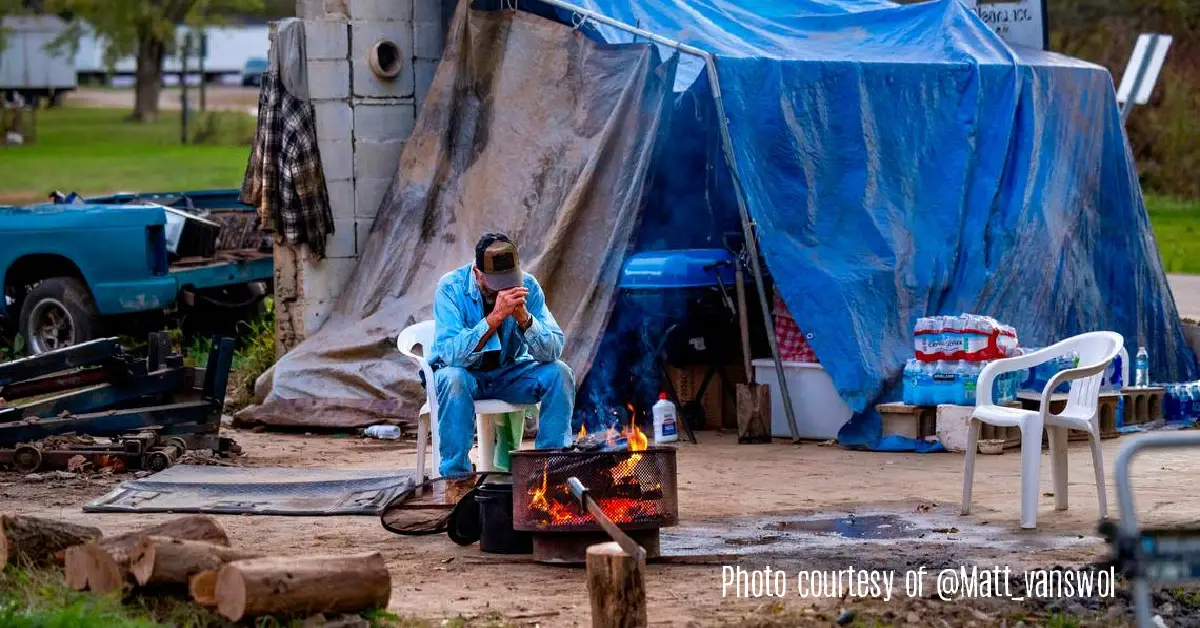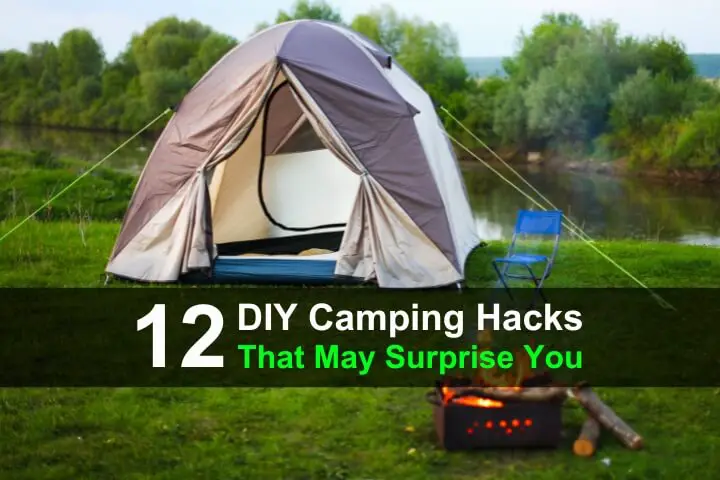(Psst: The FTC wants me to remind you that this website contains affiliate links. That means if you make a purchase from a link you click on, I might receive a small commission. This does not increase the price you’ll pay for that item nor does it decrease the awesomeness of the item. ~ Daisy)
There are scenarios we all try to prepare for, like long-term power outages, terrible storms, or other disastrous events. But as Western North Carolina demonstrates, there are some things so wildly unexpected that you just can’t prep for them. The SHTF in Western NC almost two months ago, and people are still in survival mode.
For those saying, “Well, the government will help them; that’s what we pay taxes for.” No, they won’t. In fact, they’re making a terrible situation even worse. It’s so bad that one has to wonder, is this mere incompetence, or is there something darker at play? Let’s take a closer look at this SHTF playing out in our own nation, one that most of the country is completely unaware of.
The information in this article is based on first-person accounts from the people who live there. Not every person in Western North Carolina is having the same experience. These are stories from the hardest-hit areas. These things aren’t all being reported in the MSM, and in fact, some are reporting the opposite. After the outrageous propaganda voiced there during the election, I know who I find more credible.
What happened?
This isn’t my first article on the topic. I went into detail here and here, including video documentaries.
Western North Carolina and Eastern Tennessee are part of the Appalachian Mountains. The elevation on many of the mountains is more than 6000 feet. If you live all the way up there, far from the rivers that run through the valleys of that area, flood damage would be pretty unexpected. It’s 350 miles or more from the coast, so a hurricane is also completely unexpected. Historically, Western NC has gotten some wind and rain when there are hurricanes nearby, some trees have been knocked down, and a bit of damage was done, but nothing like Helene has ever happened in these mountains.
Hurricane Helene was a full-on catastrophic disaster. There was flooding everywhere, even up in the mountains. The rivers running through the area flooded quickly. Entire forests full of trees came down, and landslides devastated the mountains.
Entire homes were completely washed away, with residents inside them. Other homes were filled with thick, toxic mud and sludge. Cars disappeared into the river, found in ruins, miles away from where they had been parked. An almost unfathomable 1400 landslides wreaked havoc on the Appalachians in Western NC and Eastern TN. Here are the stats:
The storm and its aftermath caused 1,400 landslides and damaged over 160 water and sewer systems, at least 6,000 miles (9,650 kilometers) of roads, more than 1,000 bridges and culverts and an estimated 126,000 homes, the budget office said. Some 220,000 households are expected to apply for federal assistance.
Many of those homes are completely uninhabitable right now. People are living in near-apocalyptic conditions, and no amount of physical preps could have helped them. When your entire house is washed away or filled with sludge, most, if not all, of your preps will be ruined.
Let me be extremely clear. People in Appalachia are made of different stuff. They are resilient and resourceful and a large number of them are preppers. But the scale of this disaster, an estimated $53 billion dollars worth of damage, is not something you can prep for. It’s the luck of the draw whether one of those 1400 landslides hits your house or the one next door. Homes that were not victim to landslides had other problems, like wind damage and falling trees. Very few people were unscathed.
Many, many roads were so damaged or covered in debris that they were completely impassible. So, even if you still had a car, you weren’t going anywhere.
The “immediate” government response
The response to this by both the federal and state governments has been laughably bad – at least if you have a dark sense of humor. For all the politicians expounding on what they’re going to do, very little has actually happened that is of help. Helene landed in the mountains on the evening of September 26th.
FEMA said that they had people there before Helene made landfall. Perhaps they did, but survivors said that there was no sign of them until an entire week after the storm. They did not go door to door, and search and rescue arrived a few days after that.
One thousand active duty soldiers were also sent to help with recovery efforts, and they were deployed on October 2, also a week after the storm.
Let’s be honest. After 7 days trapped in the mud or water, this was not search and rescue. This was search and recovery.
Even worse, FEMA has spoken out against people who are there, living through this disaster, sharing information, calling it disinformation.
11/20/24 update from Jason Ward on Tik Tok. So FEMA is saying that they have helped everyone in WNC and anything contrary to the FEMA narrative is mis-information. ?? pic.twitter.com/PLQS41WnLF
— ?Dennis? (@clovis1931) November 21, 2024
And despite video evidence, many folks have chosen to believe the government and not their fellow citizens.
The real heroes
The real heroes and early responders, like in any SHTF scenario, were the neighbors and the locals. There are dozens of stories about neighbors frantically digging people out of the mud or pulling them from the river. Volunteers arrived quickly, within a day or two, and began to help, using personal helicopters and small planes to find stranded people. They delivered medications, EpiPens for all reactions to the hornets that were stirred up, generators, fuel, food, and water. Mule teams from around the country soon were brought to join the effort.
These volunteers and neighbors worked tirelessly to help Appalachia days before “official” help arrived. If not for them, the death toll would have been far worse. These folks spent their own money to provide assistance, help that rightly should have been provided by our tax dollars.
The Amish deployed men to come and quickly build beautiful tiny houses to get roofs over peoples’ heads before the snow began to fly.
Some volunteers are still there, doing everything they can to assist. Though it has mostly disappeared from the national news cycle, this disaster is far from over. Emergency RVs has managed to donate 30 RVs to families in need.
In the first days after the disaster, Elon Musk rapidly deployed StarLink equipment and made communications available for free. First responders used the technology and it was also distributed to homes throughout the region.
Conditions now
Almost two months after the storm, it still looks like a bomb went off. If a picture is worth a thousand words, then video is worth a million.
If you go to Western North Carolina, in the small towns, it looks positively apocalyptic. Here’s a video taken by someone local I’ve been following during this event. She is a film director by trade, which is why it looks and sounds so professional.
??TODAY IN TENT CITY
Swannanoa, North CarolinaDo you see FEMA?
Countless families in North Carolina have been left without safe shelter. Shawn Hendrix, a survival expert, first responder and community advocate, is leading on the ground action for Operation Shelter, a… pic.twitter.com/DheZljRPrv
— Erin Derham (@HistoryBoutique) November 19, 2024
This video shows some of the destruction in Asheville, formerly a tourist hub.
Keep sharing these videos. Today, a FEMA administrator testified to a committee in Congress. “They have helped over 35,000 families”. I am sure the volunteers on the ground who are really there helping would say, “Really?”What has happened here could happen to any of us, and now… pic.twitter.com/t2GE734Hbs
— Lisa ????? (@Lisahudsonchow7) November 21, 2024
Here is another video that shows the havoc that still remains, almost two months later.
FEMA having an oversight committee and saying everything is a conspiracy theory, meanwhile here’s footage taken from just one week ago.
I see no federal employees. Do you? pic.twitter.com/dToHEE9Bge
— Frank Fighting For Freedom ?? (@thinktankfranks) November 19, 2024
The stench of death became familiar in some of the hardest hit areas, where human and animal remains had landed and began to decompose. Many of those remains have not yet been recovered.
Human remains are being found and civilians have no way to identify them.
Western North Carolina needs help! Bones are being found and those assisting with recovery operations are being ignored. They are being found in areas where cadaver dogs were hitting. In some cases animals have eaten the flesh and only bones remain. Families are privately paying… pic.twitter.com/Q5v1piDiTv
— Nashville Angela (@angelanashtn) November 13, 2024
This Bible survived the storm and has been encased as a symbol of hope for the region.
A really good look at the Bible that was thrust into a pole in North Carolina from Helene. Cajun navy got some got close up shots showing the scriptures which is really cool to see.
(Cajun navy 2016 is their division, it is not the year – want to point that out so there’s no… pic.twitter.com/GoxWSAn5uy
— Frank Fighting For Freedom ?? (@thinktankfranks) November 19, 2024
The debris piles you’re seeing in these videos are absolutely enormous. Here’s a photo for scale.
This image alone gives you a good idea of just how significant the debris field was and still is in western North Carolina from Hurricane Helene pic.twitter.com/edjb0EGmG8
— Frank Fighting For Freedom ?? (@thinktankfranks) November 20, 2024
How do you even deal with that much debris as a civilian? You can’t burn it because there could still be remains in there. The official death toll number for Appalachia is 93. Locals say that it is not even close.
Bodies are being found every day in Western North Carolina.
They are piling bodies into warehouses. pic.twitter.com/I6byhoTwU3
— Molly ?? (@LoveMyMJ69) November 18, 2024
The person with this Rumble channel has been shooting video every single day to document the ongoing crisis.
If it weren’t for Elon Musk buying Twitter, and turning it into X, nobody would know about any of this. Even with all this video evidence it’s still being called “fake news.” In many cases, the videos are being removed from TikTok.
How the government is actively making things worse
In 1986, Ronald Reagan famously said, The nine most terrifying words in the English language are ‘I’m from the government and I’m here to help.’”
The folks in Appalachia are learning just how true that is. Here is a video from a local about how FEMA is responding to the disaster.
More information coming out of western North Carolina.
FEMA needs to be investigated #helene2024 #WNC#NorthCarolina #FEMA pic.twitter.com/w9nhbT6jU3
— Based Drama (@TanyaBeard10264) November 18, 2024
But it gets even worse. FEMA has a huge number of RVs that could be distributed, and they’re not doing it. In two months, only 4 RVs have been given to families for shelter. Look how many are sitting there, empty and unused while citizens sleep on the ground in tents.
The non-profit, @EmergencyRv reports that they “begged” for RVs sitting in government storage for a 103 year old World War 2 veteran who was a victim of Helene.
They were denied.
Instead, a fellow veteran stepped up and donated his. pic.twitter.com/XQVSDo4YVW
— Matt Van Swol (@matt_vanswol) November 20, 2024
Meanwhile FEMA is boasting about the trailers nobody is getting.
?#BREAKING: Officials at FEMA have just posted a new video touring brand housing units they say are available to #WNC.
What they fail to mention in the video is that in the 2 months since in the hurricane… only FOUR UNITS have been delivered.
You read that right.
Four. pic.twitter.com/9X5HXllmqA
— Matt Van Swol (@matt_vanswol) November 20, 2024
A FEMA whistleblower has said that the organization has “no timeline” for doling out the trailers. Are you wondering why? Shawn Hendrix, who has been on the ground since Day 1 working tirelessly to help, explains.
Here is the simple reason FEMA is not placing the houses. Theses houses can’t be placed in flood plains, hmm where were most of the houses located…. I am going to rebuild a house in the tent city blue area to see if the county will block me or not. We will find out soon! pic.twitter.com/Cx5SqrS8rL
— Shawn Hendrix (@TheShawnHendrix) November 21, 2024
And just in case you think the housing situation couldn’t get any worse, there are one hundred donated tiny houses sitting empty because they “aren’t up to code,” according to authorities. They are literally making people move out of them and go back to living in tents in freezing cold weather.
UNBELIEVABLE ? North Carolina Hurricane Helene victims had someone come in and build 100 tiny homes as a donation
Victims “were living in them, and the county comes in and says they won’t pass inspection.” AND KICKS THEM OUT
“So we got 75 of them sitting down there that won’t… pic.twitter.com/LAE27roXKT
— Wall Street Apes (@WallStreetApes) November 21, 2024
If this is an example of our tax dollars at work, I want a refund. This is living proof that FEMA could be disbanded, and hardly anyone but illegal immigrants would be inconvenienced.
However much you may have despised our government and its bureaucracy in the past, you didn’t hate it enough.
Children are being removed from their families.
And just when you think things can’t possibly get any worse, the Department of Social Services stepped in, removing children from their families because of their living conditions. Some folks are dismissive and say this isn’t really happening, but it is, and the kids are being separated and sent to foster care hours away. Their parents may not have vehicles after the disaster, so they can’t even go visit them. Here are two videos regarding this.
The stories about “DHS taking kids away from parents” you’ve been hearing from people in #WNC are NOT a conspiracy theories.
Here’s how it works:
a) Your 3-generation family home sits on 52 acres deep in the Appalachian mountains, it’s not much but it’s always been home.
b)… pic.twitter.com/EyCy5EM0E1
— Matt Van Swol (@matt_vanswol) November 20, 2024
And here is an example of this happening. It’s incredibly disturbing.
Here’s the proof that officers have suggested they are calling DSS to take away a woman’s children in Bat Cave North Carolina after she lost everything from Helene.
This shows the footage of her destroyed home and the interaction she had with the officer. pic.twitter.com/WT2UTFyzU1
— Frank Fighting For Freedom ?? (@thinktankfranks) November 16, 2024
More details on the case are here.
? More CONFIRMED cases of Western North Carolina Hurricane Helene victims HAVING THEIR KIDS TAKEN AWAY
“I was just with a woman that they took her 3 children, and one of them is autistic. I said, where are they gonna put them? So they’re gonna separate them, put them in foster… pic.twitter.com/KiGUqSmuSP
— Wall Street Apes (@WallStreetApes) November 18, 2024
And there’s this one, in which the mother may lose her son permanently if she can’t go visit him hours away, with no car.
I guess it’s just not enough that people have lost so much if not everything. DPS showed up at her home and removed her son. He has been placed into a foster home 2 hours away from her. This entire story is so very disturbing and sad. Y’all do know what happens to children in… pic.twitter.com/R1ekl13V2o
— Lisa ????? (@Lisahudsonchow7) November 16, 2024
I’m personally convinced that this is a land grab, but this article is already quite long. I’ll cover that tomorrow. Right now, it’s the human element of this SHTF disaster.
How you can help
There are many different ways to help. Here are some of the people on the ground I’ve been following on X.
Emergency RV, as mentioned, has gotten 30 donated trailers to families with no homes. If you have one that you’d like to donate, you can contact them and they’ll even arrange for someone to drive it to its destination.
For information, you can follow Matt Van Swol and his wife, Erin Derham. They are posting daily from Asheville the things going on in the community. They’re extremely careful about checking their information.
Margo from NC has been posting first-hand information since the disaster began.
Shawn Hendrix, as I mentioned before, has worked tirelessly to help the community. He has brought a lot of attention to the situation and pulled off some miracles. If you want to make a monetary donation that you can be confident will be put to good use, here are some links for doing so. I trust Shawn implicitly as he has regularly shown the results of the money he has received.
If you have some donations you would like to mail in, I have an address. They are not taking most clothing right now, but are looking for outerwear for children and adults, blankets, sleeping bags, and camping gear.
Crestview Baptist Church
3258 Pisgah Dr.
Canton NC 28716
- You can also order supplies from Amazon and have it sent there. Here are a few recommendations.
- These winter sleeping bags are on sale for only $20.
- Feminine hygiene supplies like pads and tampons are needed.
- Things to keep hands and feet warm would be extremely welcome.
- No-rinse body wipes would be helpful for hygiene.
- Propane heaters that can safely be used indoors could potentially save someone’s life. My recommendations are the Little Buddy and the Mr. Heater. If you are feeling extra generous, this hose assembly allows the heaters to be connected to bigger, barbecue sized propane tanks.
- Winter gear such as gloves, coats, heavy socks, and hats are also welcome.
Manpower would also be appreciated if you can. Contact Shawn Hendrix, above, to get more information.
Please share these stories far and wide. Don’t let Appalachia be forgotten.
I’m appalled that our FEMA tax dollars are housing illegal immigrants in fancy hotels and giving them thousands of dollars to get settled, while our own people are living in third world conditions.
Insurance won’t pay for flood damage and only 5% of the people there have flood insurance. Most of these homes were well above the previous flood plain, and in areas not necessarily covered by the National Flood Insurance Program. This wasn’t negligence on their parts.
There’s nobody to help but us.
What are your thoughts?
I have more information coming tomorrow about the red tape keeping people homeless.
Did you know the situation was still so bad in Western NC? Have you ever visited this part of Appalachia? What do you think of the governmental response?
Let’s discuss it in the comments section.


















